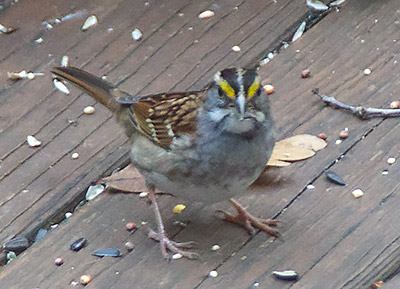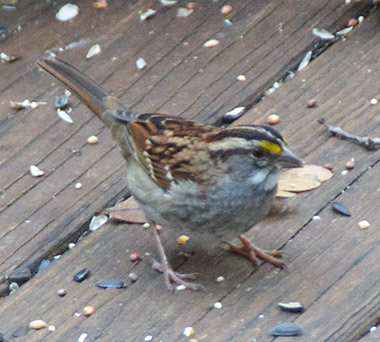White-Throated Sparrows (Zonotrichia albicollis) have recently appeared at our house. Although some sparrows can be tough to identify, this one gives itself away with its white throat and the yellow patches (lores) over its eyes. These birds breed in Canada and the very northern parts of the U.S., but they come south for the Winter. Males and females have similar coloration, but males tend to be more brightly colored.
Here is an interesting quote about these birds from Audubon: “It is a plump bird, fattening almost to excess, whilst in Louisiana, and affords delicious eating, for which purpose many are killed with blow-guns. These instruments-should you not have seen them-are prepared by the Indians, who cut the straightest canes, perforating them by forcing a hickory rod through the internal partitions which intersect this species of bamboo, and render them quite smooth within by passing the rod repeatedly through. The cane is then kept perfectly straight, and is well dried, after which it is ready for use. Splints of wood, or more frequently of cane, are then worked into tiny arrows, quite sharp at one end, and at the other, instead of being feathered, covered with squirrel hair or other soft substances, in the manner of a bottle-brush, so as to fill the tube and receive the impulse imparted by a smart puff of breath, which is sufficient to propel such an arrow with force enough to kill a small bird at the distance of eight or ten paces. With these blow-guns or pipes, several species of birds are killed in large quantities; and the Indians sometimes procure even squirrels by means of them.”
It would certainly take a lot of these little birds to make a meal, because those with “heavy fat” only average 30.3 grams (1.07 ounces) according to a paper in the Wilson Bulletin (66:2, 1954). And that is the entire weight of the bird, including the beak, feet, entrails, and other inedible parts.
The Audubon quote is from: Ornithological biography, or An account of the habits of the birds of the United States of America : accompanied by descriptions of the objects represented in the work entitled The birds of America, and interspersed with delineations of American scenery and manners / v.1 p. 43. 1839 Authors: Audubon, John James, 1785-1851., Macgillivray, William, 1796-1852. The cane mentioned by Audubon is the bamboo native to the Southeastern U. S., Arundinaria gigantea.
Discover more from A Naturalist's Journal
Subscribe to get the latest posts to your email.


